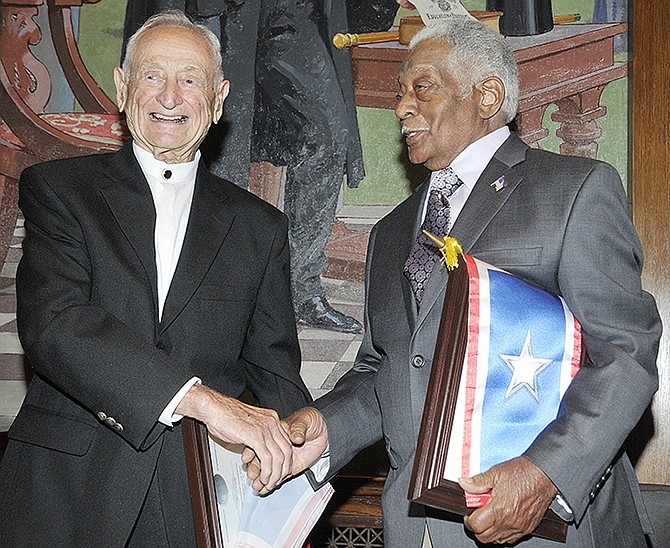Gov. Jay Nixon honored four veterans, including one from Jefferson City, with the Silver Star Banner in his office on Wednesday.
The governor honored World War II veterans Ed Gross, Jefferson City, and James Shipley, Tipton; and Korean War veteran William Stroud, Columbia; and Vietnam War veteran Wayne Wallingford, now a Republican state senator from Cape Girardeau.
Nixon established Silver Star Families of America Day as May 1 in Missouri five years ago.
Veterans who qualify receive a Silver Star Service Banner and Certificate of Recognition. Qualifications include: Purple Heart recipients; victims of friendly fire; those suffering from post-traumatic stress, traumatic brain injury, Agent Orange and Gulf War Syndrome; and those with injuries, wounds or illnesses originating in a combat zone.
The four men recognized Wednesday came from varying conflicts, but made the same sacrifices on behalf of their country, Nixon said.
"They deserve our respect year-round," he said.
Gross completed 72 combat missions in the South Pacific aboard a B-25 Mitchell, a twin-engine bomber. He was drafted in 1943 and because he had been a sheet metal worker with the B-25s, the military put him in the U.S. Air Force.
A tap-dance instructor, Gross passed the Morse code test perfectly, getting his assigned as radio operator.
Shipley enlisted to serve his country and became a Tuskegee Airman. He served as an aircraft mechanic, due to his previous experience as a vehicle mechanic.
He was assigned to the 332nd Fighter Group, dubbed the "Red Tails," in Italy.
Arriving in Italy in late January 1944, Shipley was assigned to the 332nd Fighter Group, whose pilots later painted the tails of their planes red thereby earning the famed nickname "Red Tails."
He kept American aircraft flying, including the P-39 Aircobra, P-40 Warhawk, P-47 Thunderbird and P-51 Mustang.
Stroud was wounded twice in combat. He enlisted in the U.S. Army only a month before the Korean War broke out.
He first served in the 7th Division at Teague, Korea, in the battalion pioneer and ammunition platoon. Then he requested a transfer to 31st Regiment as a rifleman, with whom he patrolled the mountains of central Korea.
His first Purple Heart was the result of a grenade attack, leaving three pieces of shrapnel lodged in his back when he returned to his unit. He was awarded a second Purple Heart after his assault team crested a ridge and the enemy opened fire with a machine gun.
Wallingford was a navigator on B52s, serving in five deployments and hundreds of bombing missions over North Vietnam. He also deployed as an intelligence officer on six tours to the Gulf War, retiring from the U.S. Air Force in 1993 at a lieutenant colonel.
The Silver Star emerged in 1917, when the American War Mothers recognized the combat wounded by covering the blue star on a family banner with silver thread. The practice continued through World War II.
The Silver Star Families of America resurrected the acknowledgment of servicemen injured in or ill from a combat zone, when it was established as a charitable organization in 2004 in Missouri.
Jeremy Amick contributed to this story.

